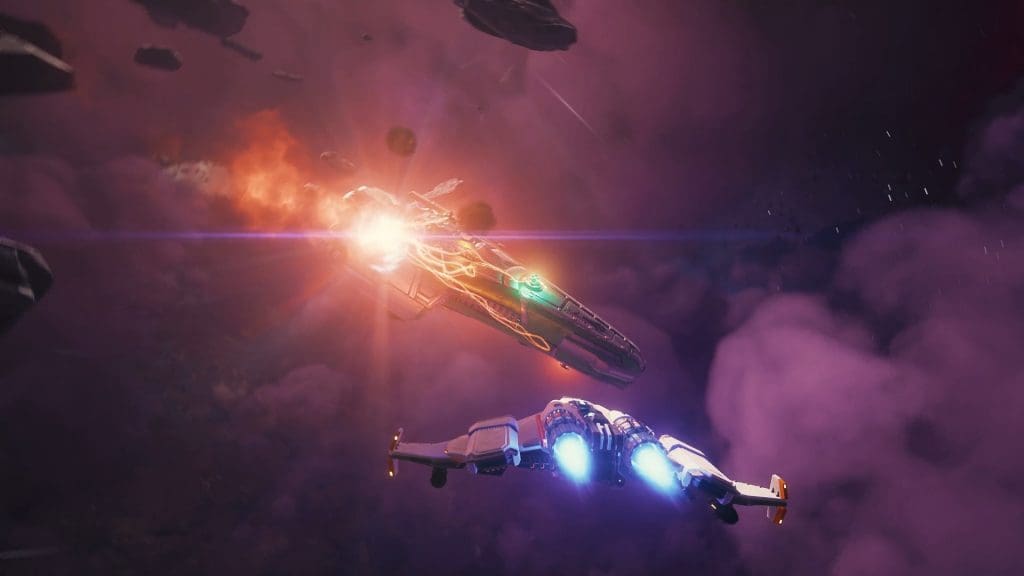I had made it to Sector 2 with seconds to spare, a wave of alien fighters hot on my tail. I’d lost my pursuers in the jump, but with failing life support and a hull damaged in more places than I cared to count, I was in serious need of repairs. A derelict shipwreck promised a chance for the materials I needed to fix my damaged ship, but that’s when a scavenger and two drone fighters jumped me. With my inertia dampening system damaged, I could barely draw a bead on any of my new attackers and I’d expended the last of my missiles before the last jump just to get here. I was done. At least my bonus for making it to a new sector would give me some extra credits to burn on upgrades before my next run. Welcome to Everspace.
This was just one of my many deaths in the world of Everspace, a fusion of space shooter mechanics with the procedurally generated randomness of a rogue-like. The six degrees of freedom (6DoF) control scheme hearkens back to the classic days of Descent, and couples gorgeous graphics with procedural generated systems and an actual storyline that unwraps over time.
One of the big draws of roguelike games is that every run is different. Everspace follows this convention with each run generating a new map, new difficulty nodes, and new random encounters. The game is divided up into six sectors with the goal to make it to the sixth sector and defeat the final boss. Each sector is broken out into four or more jump nodes, with varying levels of difficulty.
Jump nodes tend to follow a particular pattern: a few enemies that you need to either take out or run from immediately, some space features which may reward or punish you for investigating them, and an invisibly ticking clock before hostile reinforcements arrive. Choosing to run from the initial encounters will increase your own difficulty over time, because you’ll start running out of resources, but fights are also far from guaranteed wins. Enemies are quite powerful, and most ships take damage with alarming speed. It is still usually worthwhile to engage the first couple waves though, simply because the rewards in each system can be significant.
Materials found in the system can be used to craft new weapons or upgrade existing ones. Random loot crates may contain full weapon systems or more material components. Blueprints can also be unlocked to craft other items. Nanobots are used to repair hull damage or coupled with crafting materials to repair damaged ship components. There are tons of interesting decisions to be made in these layers of systems.
Destroying enemies and completing randomly generated side missions will usually net a cash payout. That’s a critical element of the between runs segment of Everspace, where there is the opportunity to upgrade one’s skill tree and ship or possibly buy additional ships. Roughly half the skill tree is for your character and stays with you regardless of which ship you’re using. These are things like better credit drops and improved options when interacting with trading vessels. Ship improvements add things like more hull hit points and additional weapon slots. Skill tree choices carry over from run to run, giving the player a gradually improving curve that will hopefully lead to successfully completing the game. All cash disappears at the start of each run, however. Just like money left at the end of a government budget cycle, spend it or lose it!
At the start of the game, you have access to only one ship, a balanced general purpose vessel with no major flaws, but no major advantages either. Available for future unlocking are two ships with more specific focuses, allowing a playstyle oriented more around stealth or a hard charging kill ’em all approach. You’ll have to put together a pretty good run to afford either of them, however. With your use it or lose it cash, there’s no opportunity to save up for a few runs.
Further cash bonuses can be acquired by completing up to three challenges generated at the start of a run. Unlike the random in-system encounters, these missions don’t change until you complete at least one of them. This helps when you’re stuck with a couple of nearly impossible challenges, but one that isn’t too difficult to accomplish. However, the random nature of the challenges can mean going for long periods without completing a single one if you get stuck with three extremely difficult ones.
Controls are well thought out for the Xbox One, with the 6DoF scheme adapted well for twin stick controllers. The left stick handles vertical and horizontal strafing, while the right stick manages pitch and combined yaw/roll. Forward and back motion is controlled with the left trigger and shoulder button, while the right trigger and shoulder button fire primary and secondary weapons. Other functions are mapped to the face buttons, D-Pad, and thumbstick clicks. It’s a busy layout, but not especially complicated to learn.

The ships themselves accelerate and decelerate almost instantaneously. Combat is less a typical maneuvering dogfight and more of an FPS-style quick turn, find enemy and fire kind of engagement. Long-time gamers who remember the Descent series of games will find maneuvering instantly familiar. Those like me who tend to play more traditional movement space combat games will find a little bit of a learning curve to deal with, but adaptation comes quickly. While my personal preference would be to for ships to carry a bit more thrust inertia rather than turn on a dime while giving you nine cents change, the formula does work well here. Just keep in mind that this isn’t a space sim featuring Newtonian physics, it’s an FPS that allows vertical strafing.
A rare thing in roguelikes, Everspace features a well thought out plot and full voice acting. After your character finds himself stuck in the cockpit of a fighter with only fragments of memory for how he got there, the ship’s helpful AI works to guide him through the world and help him to die a bit less often. Progressing further through the world reveals more of the set story and includes a reasonable explanation for our hero’s remarkably high mortality rate.
Everspace offers a lot for both rogue-like and space combat genre aficionados. Rogue-like players who enjoyed FTL: Faster than Light will find a familiar map system, a well thought out progression tree, and a well designed random system generator. Space sim fans will love the eye candy graphics, frantic action, and weaving in and out of asteroids, shipwrecks, and nebulae. Easy/Medium/Hard difficulty levels provide the right amount of challenge for players of all skill levels.
You’ll die a lot, but each death is only an opportunity to start over a little bit better.
Everspace is available on Xbox One and PC with VR support through Steam on PC. For more information, check out the official website.







